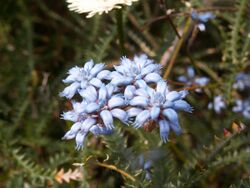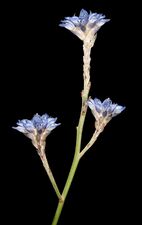Biology:Conospermum caeruleum
| Blue brother | |
|---|---|

| |
| Scientific classification | |
| Kingdom: | Plantae |
| Clade: | Tracheophytes |
| Clade: | Angiosperms |
| Clade: | Eudicots |
| Order: | Proteales |
| Family: | Proteaceae |
| Genus: | Conospermum |
| Species: | C. caeruleum
|
| Binomial name | |
| Conospermum caeruleum | |
| Synonyms[1] | |
|
Connospermum coeruleum B.D.Jacks. orth. var. | |
Conospermum caeruleum, commonly known as blue brother, is a shrub in the family Proteaceae and is endemic to the south west of Western Australia. It is a prostrate shrub with small, dense heads of blue, rarely pink flowers and usually grows in heavy soils subject to flooding.
Description
It grows as a prostrate or straggly shrub usually growing to a height of about 0.5–1.0 metre (2–3 ft) and a spread of up to 2 metres (7 ft). The leaves are clustered at the base of the stem, have a stalk 5–60 millimetres (0.2–2 in) and a leaf blade that is thread-like to egg-shaped and 14–148 millimetres (0.6–6 in). The leaves have prominent veins and end abruptly in a sharp point. The flowers are arranged in dense clusters of up to 18 tube-like blue flowers, each about 5–8 millimetres (0.2–0.3 in) long. Flowers appear between July and October and are followed by the fruit which is a nut about 2 millimetres (0.08 in) long and 2–2.5 millimetres (0.08–0.1 in) wide.[2][3][4]
Taxonomy
Conospermum caeruleum was first formally described in 1810 by Robert Brown and the description was published in Transactions of the Linnean Society of London from a specimen collected near "King George's Sound, west coast of New Holland".[5][6] The specific epithet (caeruleum) is a Latin word meaning "sky-blue".[7]
Six subspecies are recognised by the Australian Plant Census as at November 2020:
- Conospermum caeruleum R.Br. subsp. caeruleum[8]
- Conospermum caeruleum subsp. contortum E.M.Benn.[9]
- Conospermum caeruleum subsp. debile (Kippist ex Meisn.) E.M.Benn.[10]
- Conospermum caeruleum subsp. marginatum (Meisn.) E.M.Benn.[11]
- Conospermum caeruleum subsp. oblanceolatum E.M.Benn.[12]
- Conospermum caeruleum subsp. spathulatum Benth. E.M.Benn.[13]
Distribution and habitat
Conospermum caeruleum occurs from Busselton to east of Albany[2] in the Avon Wheatbelt, Esperance, Geraldton Sandplains, Jarrah Forest, Mallee, Swan Coastal Plain and Warren biogeographical regions of Western Australia[14] growing on sand, sandy peat, stony clay, laterite or granite in areas that are wet in winter.[15]
Use in horticulture
Conospermum species, especially the Western Australian ones are difficult to cultivate.[16]
Conservation status
Conospermum caeruleum is classified as "not threatened" by the Government of Western Australia Department of Parks and Wildlife.[14]
Gallery
References
- ↑ 1.0 1.1 "Conospermum caeruleum". Australian Plant Census. https://biodiversity.org.au/nsl/services/apc-format/display/83346.
- ↑ 2.0 2.1 Bennett, E. M.. "Conospermum caeruleum". Flora of Australia Online (derived from Flora of Australia Volumes 16 (1995), 17A (2000) and 17B (1999)). https://profiles.ala.org.au/opus/foa/profile/Conospermum%20caeruleum.
- ↑ Corrick, Margaret G.; Fuhrer, Bruce A. (2009). Wildflowers of southern Western Australia (3rd ed.). Kenthurst, N.S.W.: Rosenberg Pub.. p. 160. ISBN 9781877058844.
- ↑ Stone, Lynley M. (2003). "Floral biology and propagation of blue-flowered Conospermum species". PhD Thesis: 4. http://researchrepository.murdoch.edu.au/351/2/02Whole.pdf. Retrieved 1 January 2016.
- ↑ "Conospermum caeruleum". APNI. http://id.biodiversity.org.au/name/apni/75928.
- ↑ Brown, Robert (1810). "On the natural order of plants called Proteaceae". Transactions of the Linnean Society of London 10 (1): 144–145. https://www.biodiversitylibrary.org/item/13720#page/160/mode/1up. Retrieved 1 January 2016.
- ↑ Brown, Roland Wilbur (1956). The Composition of Scientific Words. Washington, D.C.: Smithsonian Institution Press. p. 177.
- ↑ "Conospermum caeruleum subsp. caeruleum". Australian Plant Census. https://biodiversity.org.au/nsl/services/apc-format/display/83346.
- ↑ "Conospermum caeruleum subsp. contortum". Australian Plant Census. https://biodiversity.org.au/nsl/services/apc-format/display/165064.
- ↑ "Conospermum caeruleum subsp. debile". Australian Plant Census. https://biodiversity.org.au/nsl/services/apc-format/display/161504.
- ↑ "Conospermum caeruleum subsp. marginatum". Australian Plant Census. https://biodiversity.org.au/nsl/services/apc-format/display/164318.
- ↑ "Conospermum caeruleum subsp. oblanceolatum". Australian Plant Census. https://biodiversity.org.au/nsl/services/apc-format/display/161213.
- ↑ "Conospermum caeruleum subsp. spathulatum". Australian Plant Census. https://biodiversity.org.au/nsl/services/apc-format/display/165063.
- ↑ 14.0 14.1 "Conospermum caerulum". FloraBase. Western Australian Government Department of Parks and Wildlife. https://florabase.dpaw.wa.gov.au/browse/profile/1862.
- ↑ Paczkowska, Grazyna; Chapman, Alex R. (2000). The Western Australian flora : a descriptive catalogue. Perth: Wildflower Society of Western Australia. pp. 469. ISBN 0646402439.
- ↑ Wrigley, John W.; Fagg, Murray (1983). Australian native plants : a manual for their propagation, cultivation and use in landscaping (2nd ed.). Sydney: Collins. pp. 200–201. ISBN 0002165759.
External links
Wikidata ☰ Q15574845 entry
 |



